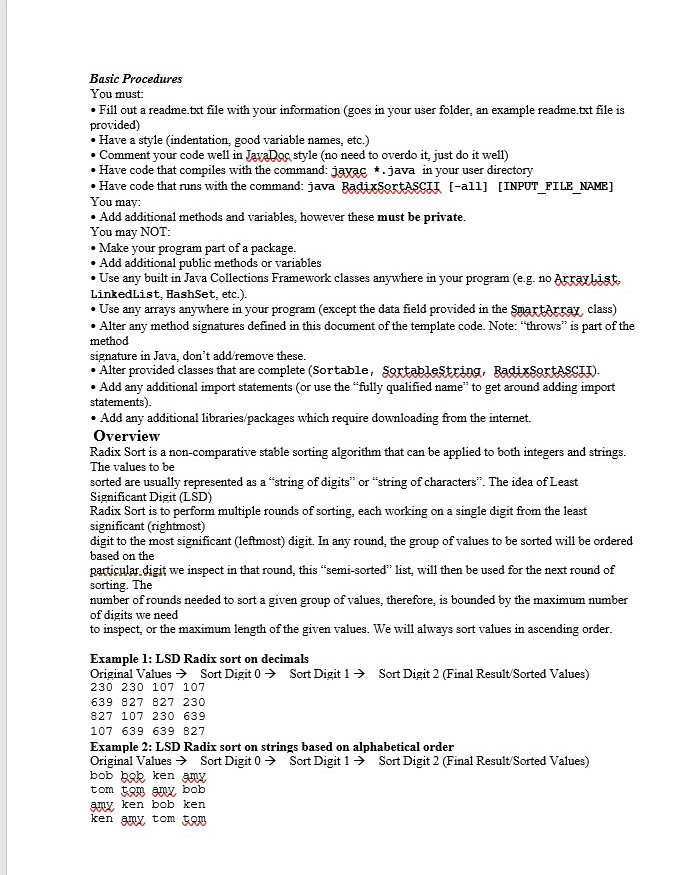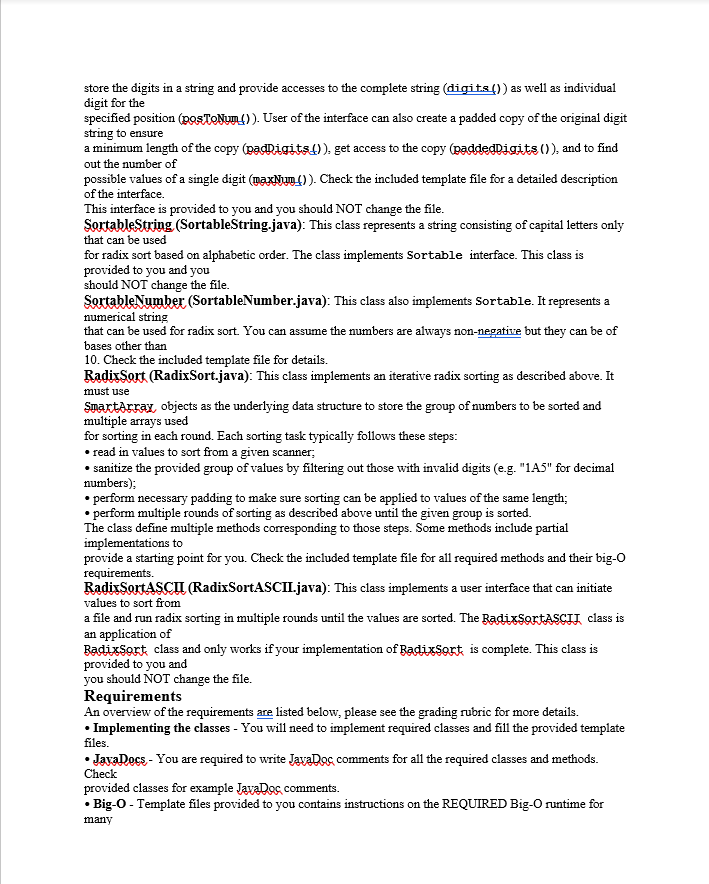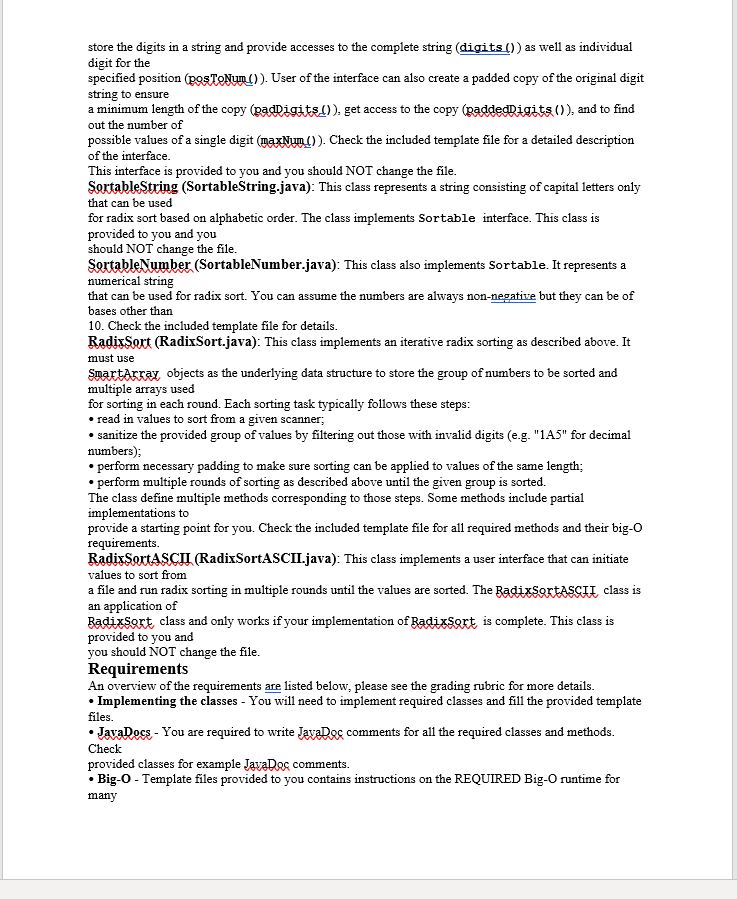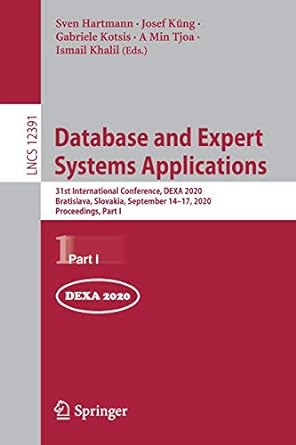Answered step by step
Verified Expert Solution
Question
1 Approved Answer
Hi, I have to finish this project and it has to be written in java, can someone give me a hand please? Basic Procedures You
Hi,
I have to finish this project and it has to be written in java, can someone give me a hand please?




Basic Procedures You must: Fill out a readme.txt file with your information (goes in your user folder, an example readme.txt file is provided) Have a style (indentation, good variable names, etc.) Comment your code well in JavaDoc style (no need to overdo it, just do it well) .Have code that compiles with the command: jayac *.java in your user directory .Have code that runs with the command: java BadixSortASCII -all] [INPUT_FILE NAME] You may: . Add additional methods and variables, however these must be private. You may NOT Make your program part of a package. . Add additional public methods or variables Use any built in Java Collections Framework classes anywhere in your program (e.g. no ArrayList. LinkedList, HashSet, etc.). Use any arrays anywhere in your program (except the data field provided in the SmartArray, class) . Alter any method signatures defined in this document of the template code. Note: "throws" is part of the method signature in Java, don't add/remove these Alter provided classes that are complete (Sortable, SortableString, BadixSortASCI) . Add any additional import statements (or use the "fully qualified name" to get around adding import statements) . Add any additional libraries/packages which require downloading from the internet. Overview Radix Sort is a non-comparative stable sorting algorithm that can be applied to both integers and strings. The values to be sorted are usually represented as a "string of digits" or "string of characters". The idea of Least Significant Digit (LSD) Radix Sort is to perform multiple rounds of sorting, each working on a single digit from the least significant (rightmost) digit to the most significant (leftmost) digit. In any round, the group of values to be sorted will be ordered based on the particular.digit we inspect in that round, this "semi-sorted list, will then be used for the next round of sorting. The number ofrounds needed to sort a given group of values, therefore, is bounded by the maximum number of digits we need to inspect, or the maximum length of the given values. We will always sort values in ascending order Example 1: LSD Radix sort on decimals Original Values Sort Digit 0 Sort Digit 1 Sort Digit 2 (Final Result Sorted Values) 230 230 107 107 639 827 827 230 827 107 230 639 107 639 639 827 Example 2: LSD Radix sort on strings based on alphabetical order Original Values Sort Digit 0 Sort Digit 1 Sort Digit 2 (Final Result Sorted Values) amy ken bob ken store the digits in a string and provide accesses to the complete string (digits()) as well as individual digit for the specified position (posToNum.()). User of the interface can also create a padded copy of the original digit string to ensure a minimum length of the copy (padDigitsf)), get access to the copy (paddedDigits), and to find out the number of possible values of a single digit (paxNun.)). Check the included template file for a detailed description of the interface. This interface is provided to you and you should NOT change the file SortableString (SortableString.java): This class represents a string consisting of capital letters only that can be used for radix sort based on alphabetic order. The class implements Sortable interface. This class is provided to you and you should NOT change the file. SortableNumber (SortableNumber.java): This class also implements Sortable. It represents a numerical string that can be used for radix sort. You can assume the numbers are always non-negative but they can be of bases other than 10. Check the included template file for details. RadixSort (RadixSort.java): This class implements an iterative radix sorting as described above. It must use SmartArray, objects as the underlying data structure to store the group of numbers to be sorted and multiple arrays used for sorting in each round. Each sorting task typically follows these steps read in values to sort from a given scanner, sanitize the provided group of values by filtering out those with invalid digits (e.g. "1A5" for decimal numbers); perform necessary padding to make sure sorting can be applied to values of the same length; perform multiple rounds of sorting as described above until the given group is sorted. The class define multiple methods corresponding to those steps. Some methods include partial imp provide a starting point for you. Check the included template file for all required methods and their big-O requirements. RadissortA RadixSort ASCII.java): This class implements a user interface that can initiate values to sort from a file and run radix sorting in multiple rounds until the values are sorted. The BadixSortASCTI class is an application of BadixSort class and only works if your implementation of BadixSort is complete. This class is provided to you and you should NOT change the file. Requirements An overview of the requirements are listed below, please see the grading rubric for more details. Implementing the classes - You will need to implement required classes and fill the provided template files. JaaDocs- You are required to write JavaDos comments for all the required classes and methods. Check provided classes for example JavaDos comments. Big-O - Template files provided to you contains instructions on the REQUIRED Big-O runtime for many ementations to store the digits in a string and provide accesses to the complete string (digits ()) as well as individual digit for the specified position (posToNun()). User of the interface can also create a padded copy of the original digit string to ensure a minimum length of the copy (pad Aggt ), get access to the copy (padaegRA() ), and to find out the number of possible values of a single digit (paxNum()). Check the included template file for a detailed description of the interface This interface is provided to you and you should NOT change the file. SortableString (SortableString.java): This class represents a string consisting of capital letters only that can be used for radix sort based on alphabetic order. The class implements Sortable interface. This class is provided to you and you should NOT change the file. SortableNumber (SortableNumber.java): This class also implements Sortable. It represents a numerical string that can be used for radix sort. You can assume the numbers are always non-negative but they can be of bases other than 10. Check the included template file for details. RadixSort (RadixSort.java): This class implements an iterative radix sorting as described above. It must use SnartArray, objects as the underlying data structure to store the group of numbers to be sorted and multiple arrays used for sorting in each round. Each sorting task typically follows these steps: read in values to sort from a given scanner; sanitize the provided group of values by filtering out those with invalid digits (e.g. "1A5" for decimal numbers) perform necessary padding to make sure sorting can be applied to values of the same length; perform multiple rounds of sorting as described above until the given group is sorted. The class define multiple methods corresponding to those steps. Some methods include partial implementations to provide a starting point for you. Check the included template file for all required methods and their big-O requirements. RadixSortASCIT (RadixSortASCII.java): This class implements a user interface that can initiate values to sort from a file and run radix sorting in multiple rounds until the values are sorted. The Bad A GI class is an application of Bad SAK class and only works if your implementation of Baussort is complete. This class is provided to you and you should NOT change the file. Requirements An overview of the requirements are listed below, please see the grading rubric for more detail:s Implementing the classes - You will need to implement required classes and fill the provided template files . JayaDec8. You are required to write JayaRgg comments for all the required classes and methods. Check provided classes for example JavaDec comments. .Big-O - Template files provided to you contains instructions on the REQUIRED Big-O runtime for many store the digits in a string and provide accesses to the complete string (digits ()) as well as individual digit for the specified position (posToNun()). User of the interface can also create a padded copy of the original digit string to ensure a minimum length of the copy (pad Aggt ), get access to the copy (padaegRA() ), and to find out the number of possible values of a single digit (paxNum()). Check the included template file for a detailed description of the interface This interface is provided to you and you should NOT change the file. SortableString (SortableString.java): This class represents a string consisting of capital letters only that can be used for radix sort based on alphabetic order. The class implements Sortable interface. This class is provided to you and you should NOT change the file. SortableNumber (SortableNumber.java): This class also implements Sortable. It represents a numerical string that can be used for radix sort. You can assume the numbers are always non-negative but they can be of bases other than 10. Check the included template file for details. RadixSort (RadixSort.java): This class implements an iterative radix sorting as described above. It must use SnartArray, objects as the underlying data structure to store the group of numbers to be sorted and multiple arrays used for sorting in each round. Each sorting task typically follows these steps: read in values to sort from a given scanner; sanitize the provided group of values by filtering out those with invalid digits (e.g. "1A5" for decimal numbers) perform necessary padding to make sure sorting can be applied to values of the same length; perform multiple rounds of sorting as described above until the given group is sorted. The class define multiple methods corresponding to those steps. Some methods include partial implementations to provide a starting point for you. Check the included template file for all required methods and their big-O requirements. RadixSortASCIT (RadixSortASCII.java): This class implements a user interface that can initiate values to sort from a file and run radix sorting in multiple rounds until the values are sorted. The Bad A GI class is an application of Bad SAK class and only works if your implementation of Baussort is complete. This class is provided to you and you should NOT change the file. Requirements An overview of the requirements are listed below, please see the grading rubric for more detail:s Implementing the classes - You will need to implement required classes and fill the provided template files . JayaDec8. You are required to write JayaRgg comments for all the required classes and methods. Check provided classes for example JavaDec comments. .Big-O - Template files provided to you contains instructions on the REQUIRED Big-O runtime for many Basic Procedures You must: Fill out a readme.txt file with your information (goes in your user folder, an example readme.txt file is provided) Have a style (indentation, good variable names, etc.) Comment your code well in JavaDoc style (no need to overdo it, just do it well) .Have code that compiles with the command: jayac *.java in your user directory .Have code that runs with the command: java BadixSortASCII -all] [INPUT_FILE NAME] You may: . Add additional methods and variables, however these must be private. You may NOT Make your program part of a package. . Add additional public methods or variables Use any built in Java Collections Framework classes anywhere in your program (e.g. no ArrayList. LinkedList, HashSet, etc.). Use any arrays anywhere in your program (except the data field provided in the SmartArray, class) . Alter any method signatures defined in this document of the template code. Note: "throws" is part of the method signature in Java, don't add/remove these Alter provided classes that are complete (Sortable, SortableString, BadixSortASCI) . Add any additional import statements (or use the "fully qualified name" to get around adding import statements) . Add any additional libraries/packages which require downloading from the internet. Overview Radix Sort is a non-comparative stable sorting algorithm that can be applied to both integers and strings. The values to be sorted are usually represented as a "string of digits" or "string of characters". The idea of Least Significant Digit (LSD) Radix Sort is to perform multiple rounds of sorting, each working on a single digit from the least significant (rightmost) digit to the most significant (leftmost) digit. In any round, the group of values to be sorted will be ordered based on the particular.digit we inspect in that round, this "semi-sorted list, will then be used for the next round of sorting. The number ofrounds needed to sort a given group of values, therefore, is bounded by the maximum number of digits we need to inspect, or the maximum length of the given values. We will always sort values in ascending order Example 1: LSD Radix sort on decimals Original Values Sort Digit 0 Sort Digit 1 Sort Digit 2 (Final Result Sorted Values) 230 230 107 107 639 827 827 230 827 107 230 639 107 639 639 827 Example 2: LSD Radix sort on strings based on alphabetical order Original Values Sort Digit 0 Sort Digit 1 Sort Digit 2 (Final Result Sorted Values) amy ken bob ken store the digits in a string and provide accesses to the complete string (digits()) as well as individual digit for the specified position (posToNum.()). User of the interface can also create a padded copy of the original digit string to ensure a minimum length of the copy (padDigitsf)), get access to the copy (paddedDigits), and to find out the number of possible values of a single digit (paxNun.)). Check the included template file for a detailed description of the interface. This interface is provided to you and you should NOT change the file SortableString (SortableString.java): This class represents a string consisting of capital letters only that can be used for radix sort based on alphabetic order. The class implements Sortable interface. This class is provided to you and you should NOT change the file. SortableNumber (SortableNumber.java): This class also implements Sortable. It represents a numerical string that can be used for radix sort. You can assume the numbers are always non-negative but they can be of bases other than 10. Check the included template file for details. RadixSort (RadixSort.java): This class implements an iterative radix sorting as described above. It must use SmartArray, objects as the underlying data structure to store the group of numbers to be sorted and multiple arrays used for sorting in each round. Each sorting task typically follows these steps read in values to sort from a given scanner, sanitize the provided group of values by filtering out those with invalid digits (e.g. "1A5" for decimal numbers); perform necessary padding to make sure sorting can be applied to values of the same length; perform multiple rounds of sorting as described above until the given group is sorted. The class define multiple methods corresponding to those steps. Some methods include partial imp provide a starting point for you. Check the included template file for all required methods and their big-O requirements. RadissortA RadixSort ASCII.java): This class implements a user interface that can initiate values to sort from a file and run radix sorting in multiple rounds until the values are sorted. The BadixSortASCTI class is an application of BadixSort class and only works if your implementation of BadixSort is complete. This class is provided to you and you should NOT change the file. Requirements An overview of the requirements are listed below, please see the grading rubric for more details. Implementing the classes - You will need to implement required classes and fill the provided template files. JaaDocs- You are required to write JavaDos comments for all the required classes and methods. Check provided classes for example JavaDos comments. Big-O - Template files provided to you contains instructions on the REQUIRED Big-O runtime for many ementations to store the digits in a string and provide accesses to the complete string (digits ()) as well as individual digit for the specified position (posToNun()). User of the interface can also create a padded copy of the original digit string to ensure a minimum length of the copy (pad Aggt ), get access to the copy (padaegRA() ), and to find out the number of possible values of a single digit (paxNum()). Check the included template file for a detailed description of the interface This interface is provided to you and you should NOT change the file. SortableString (SortableString.java): This class represents a string consisting of capital letters only that can be used for radix sort based on alphabetic order. The class implements Sortable interface. This class is provided to you and you should NOT change the file. SortableNumber (SortableNumber.java): This class also implements Sortable. It represents a numerical string that can be used for radix sort. You can assume the numbers are always non-negative but they can be of bases other than 10. Check the included template file for details. RadixSort (RadixSort.java): This class implements an iterative radix sorting as described above. It must use SnartArray, objects as the underlying data structure to store the group of numbers to be sorted and multiple arrays used for sorting in each round. Each sorting task typically follows these steps: read in values to sort from a given scanner; sanitize the provided group of values by filtering out those with invalid digits (e.g. "1A5" for decimal numbers) perform necessary padding to make sure sorting can be applied to values of the same length; perform multiple rounds of sorting as described above until the given group is sorted. The class define multiple methods corresponding to those steps. Some methods include partial implementations to provide a starting point for you. Check the included template file for all required methods and their big-O requirements. RadixSortASCIT (RadixSortASCII.java): This class implements a user interface that can initiate values to sort from a file and run radix sorting in multiple rounds until the values are sorted. The Bad A GI class is an application of Bad SAK class and only works if your implementation of Baussort is complete. This class is provided to you and you should NOT change the file. Requirements An overview of the requirements are listed below, please see the grading rubric for more detail:s Implementing the classes - You will need to implement required classes and fill the provided template files . JayaDec8. You are required to write JayaRgg comments for all the required classes and methods. Check provided classes for example JavaDec comments. .Big-O - Template files provided to you contains instructions on the REQUIRED Big-O runtime for many store the digits in a string and provide accesses to the complete string (digits ()) as well as individual digit for the specified position (posToNun()). User of the interface can also create a padded copy of the original digit string to ensure a minimum length of the copy (pad Aggt ), get access to the copy (padaegRA() ), and to find out the number of possible values of a single digit (paxNum()). Check the included template file for a detailed description of the interface This interface is provided to you and you should NOT change the file. SortableString (SortableString.java): This class represents a string consisting of capital letters only that can be used for radix sort based on alphabetic order. The class implements Sortable interface. This class is provided to you and you should NOT change the file. SortableNumber (SortableNumber.java): This class also implements Sortable. It represents a numerical string that can be used for radix sort. You can assume the numbers are always non-negative but they can be of bases other than 10. Check the included template file for details. RadixSort (RadixSort.java): This class implements an iterative radix sorting as described above. It must use SnartArray, objects as the underlying data structure to store the group of numbers to be sorted and multiple arrays used for sorting in each round. Each sorting task typically follows these steps: read in values to sort from a given scanner; sanitize the provided group of values by filtering out those with invalid digits (e.g. "1A5" for decimal numbers) perform necessary padding to make sure sorting can be applied to values of the same length; perform multiple rounds of sorting as described above until the given group is sorted. The class define multiple methods corresponding to those steps. Some methods include partial implementations to provide a starting point for you. Check the included template file for all required methods and their big-O requirements. RadixSortASCIT (RadixSortASCII.java): This class implements a user interface that can initiate values to sort from a file and run radix sorting in multiple rounds until the values are sorted. The Bad A GI class is an application of Bad SAK class and only works if your implementation of Baussort is complete. This class is provided to you and you should NOT change the file. Requirements An overview of the requirements are listed below, please see the grading rubric for more detail:s Implementing the classes - You will need to implement required classes and fill the provided template files . JayaDec8. You are required to write JayaRgg comments for all the required classes and methods. Check provided classes for example JavaDec comments. .Big-O - Template files provided to you contains instructions on the REQUIRED Big-O runtime for many
Step by Step Solution
There are 3 Steps involved in it
Step: 1

Get Instant Access to Expert-Tailored Solutions
See step-by-step solutions with expert insights and AI powered tools for academic success
Step: 2

Step: 3

Ace Your Homework with AI
Get the answers you need in no time with our AI-driven, step-by-step assistance
Get Started


